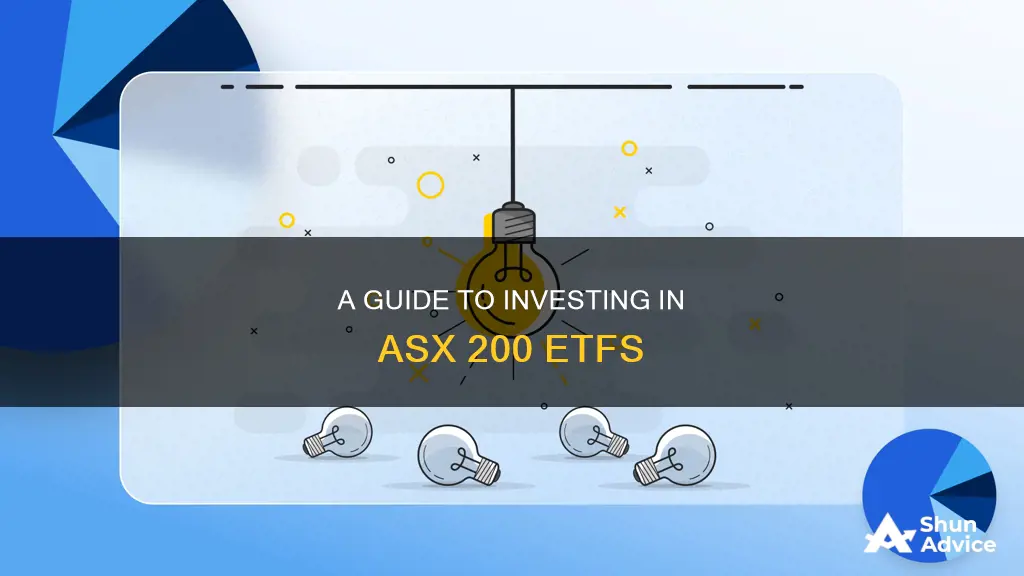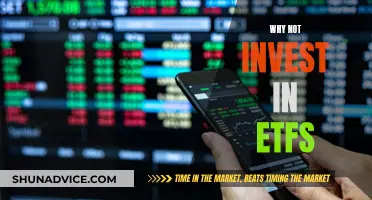
The ASX 200 is a share market index representing 200 large-cap companies listed on the Australian Securities Exchange (ASX). It is the leading Australian stock index and the local equivalent of US stock indices like the S&P 500 and Nasdaq 100.
The best way to invest in the ASX 200 is by buying an exchange-traded fund (ETF) that tracks its performance. ETFs are funds that invest in all the companies that make up a certain index, in this case, the ASX 200. This is a much more cost-effective option than buying each of the 200 individual stocks that make up the ASX 200 index.
To invest in an ASX 200 ETF, you will need to sign up with a trading platform or stockbroker. You could either go with a full-service broker or use an online share trading platform for a lower price.
1. Compare trading platforms and choose one that offers low brokerage fees on Australian stock trades.
2. Sign up for an account and verify your identity.
3. Deposit funds into your account.
4. Find the ASX 200 ETF you want to buy, considering the one with the lowest fees.
5. Select how much you want to buy, review the transaction, and complete the trade.
It is important to note that investing in the share market comes with risks as share prices can decrease in value.
| Characteristics | Values |
|---|---|
| Description | The ASX 200 is a share market index which represents 200 large-cap companies listed on the Australian Securities Exchange. |
| Number of companies | 200 |
| Companies | Think big banks like the Commonwealth Bank and Westpac, as well as mining giants like BHP and Rio Tinto. |
| Trading hours | 8am on Monday until 7am on Saturday (AEST)* |
| Initial capital required | 100% of purchase price |
| Trading options | Trading the ASX 200 directly, trading on the Australia 200’s value, trading Australia 200 Cash index CFD, trading Australia 200 index futures CFDs, trading Australia 200 Option CFDs |
| Trading platforms | CMVC Invest, Tiger Brokers, Morgan Stanley |
| ETFs | Betashares Australia 200 ETF, iShares Core S&P/ASX 200 ETF, BetaShares FTSE RAFI Australia 200 ETF |
| Dividend yield | 4.15% p.a. over the last 13 years |
What You'll Learn

What is the ASX 200?
The S&P/ASX 200 Index (ASX: XJO), or ASX 200, is an Australian share market index comprising the top 200 companies by market capitalisation listed on the Australian Securities Exchange (ASX). It was launched on 3 April 2000 and is Australia's leading share market index, accounting for around 80% of the country's equity market.
The ASX 200 is a key performance benchmark for the Australian share market and often serves as a proxy for the health of the broader economy. It is also a valuable yardstick to compare the performance of an individual stock or an entire portfolio.
The ASX 200 includes companies from 11 sectors: Consumer Discretionary, Consumer Staples, Energy, Financials, Healthcare, Industrials, Information Technology, Materials, Real Estate, Communication Services, and Utilities.
The index is calculated by Standard & Poor (S&P) and is rebalanced every quarter in March, June, September, and December to ensure that it continues to reflect the performance of the 200 largest listed companies.
The ASX 200 is a popular choice for local investors, and it is possible to invest in the index through exchange-traded funds (ETFs) or by trading individual shares.
China ETF: A Guide to Investing in the Dragon's Economy
You may want to see also

How to trade or invest in the ASX 200
The ASX 200 is a share market index representing 200 large-cap companies listed on the Australian Securities Exchange (ASX). It is the leading Australian stock index and the local equivalent of US stock indices like the S&P 500 and Nasdaq 100.
Firstly, decide whether you want to trade or invest in ETFs and individual shares, or trade on the Australia 200's value. Then, create a trading plan, deciding whether you are a short- or long-term trader and how you will manage your risk.
If you want to trade the ASX 200, you can open a live CFD trading and/or share trading account. Trading the ASX 200 is made possible through financial derivatives such as CFDs. A CFD will enable you to speculate on the ASX 200 rising or falling because it mirrors the price of the underlying market.
If you want to invest in the ASX 200, you can't invest directly as it is an index, but you can gain exposure to its price by buying and selling ASX 200 ETFs or individually-listed ASX 200 shares. When investing in shares of ASX 200 companies or ETFs, you'll need to commit the full value of the position upfront because you'll be taking direct ownership of the shares.
Best Ways to Invest in the ASX 200
The best way to invest in the ASX 200 is by buying an exchange-traded fund (ETF) that tracks the performance of the ASX 200. ETFs are ideal for new investors because they have a very low minimum investment and are highly convenient.
- Betashares Australia 200 ETF
- IShares Core S&P/ASX 200 ETF
- BetaShares FTSE RAFI Australia 200 ETF
To invest in an ASX 200 ETF, you'll need to sign up with a trading platform or stockbroker. You could either go with a full-service broker like Morgan Stanley or use an online share trading platform for a lower price.
When choosing a trading platform, look for one that offers low brokerage fees on Australian stock trades. For example, CMVC Invest and Tiger Brokers offer $0 brokerage on all ETF trades (up to a max of $1,000 for CMC Invest).
Once you've signed up and verified your identity, you can deposit funds into your account by bank transfer and then find the ETF you want to buy. When choosing an ETF, look for one with low fees. For example, the BetaShares Australia 200 ETF has a management fee of 0.04%, while the iShares and SPDR ETFs have fees of 0.05%.
Other Ways to Invest in the ASX 200
Other ways to invest in the ASX 200 include:
- Index funds or mutual funds: These are similar to ETFs in that they have low management fees and you can buy shares through your online broker. However, they are only priced at the end of each trading day, so you can only buy or sell shares in the fund once per day. They also tend to have a higher minimum investment.
- S&P ASX 200 stocks: Instead of investing in an ETF, you could buy shares in the individual stocks that the index tracks, particularly the largest companies by market capitalisation. This option offers more flexibility but requires more hands-on management, so it's better suited to more experienced investors.
A Beginner's Guide to S&P 500 ETF Investing
You may want to see also

What are the best ASX 200 ETFs?
The ASX 200 is a market-capitalisation-weighted index, tracking the performance of the 200 largest companies listed on the Australian Securities Exchange (ASX).
There are several Exchange-Traded Funds (ETFs) that track the ASX 200, and here are some of the best ones:
Betashares Australia 200 ETF
Betashares Australia 200 ETF has been one of the fastest-growing ASX 200 ETFs, with assets under management growing from $50 million to $6.1 billion since its launch in May 2018. It has a low management fee of 0.04% p.a., which is competitive compared to other ETFs in the category.
IShares Core S&P/ASX 200 ETF
IShares Core S&P/ASX 200 ETF is one of the largest ASX 200 ETFs, with $6.2 billion in assets under management. It has a slightly higher management fee of 0.05% p.a. but offers broad exposure to the Australian share market.
SPDR S&P/ASX 200 ETF
SPDR S&P/ASX 200 ETF is another popular choice, with a management fee of 0.05% p.a. It has been recognised for its low slippage, which refers to the loss incurred when buying or selling an ETF, at 0.03%.
VanEck Australian Equal Weight ETF
The VanEck Australian Equal Weight ETF (ASX: MVW) is a unique offering that invests proportionately across 80 large and mid-cap Australian shares. While it has a higher fee of 0.35% p.a., it provides better diversification than market-weighted ETFs. It has been awarded a Silver Medalist rating by Morningstar analysts.
Vanguard Australian Shares Index ETF
The Vanguard Australian Shares Index ETF (VAS) is a popular choice due to its low expense ratio of 0.07% p.a. and Vanguard's consistent track record of lowering fees. It offers exposure to the ASX 300 index, providing a broader range of Australian shares than the ASX 200.
When choosing an ASX 200 ETF, it is important to consider factors such as fees, tracking error, buy/sell spread, and the level of diversification offered by the underlying index.
Robin Hood's ETF Investment: What You Need to Know
You may want to see also

How to buy an ASX 200 ETF
To buy an ASX 200 ETF, you'll first need to sign up with a trading platform or stockbroker. You could either go with a full-service broker like Morgan Stanley or use an online share trading platform for about a tenth of the price.
Once you've chosen a trading app, you'll need to sign up for an account by providing some personal information and verifying your identity. After you've been verified, you can deposit funds into your account by bank transfer.
Next, you'll want to find the right ETF for you. As of October 2024, there were over 360 ASX-listed ETFs to choose from. When choosing an ETF, look for one with low brokerage fees and management fees.
Once your account has been funded, navigate to the trading section and search for the ASX 200 ETF you want to buy. Select how much you want to buy, review the transaction, then hit "Buy" to complete the trade.
Best ETFs to Invest in This Year
You may want to see also

Pros and cons of investing in the ASX 200
The ASX 200 is a share market index representing 200 large-cap companies listed on the Australian Securities Exchange (ASX). It is the leading Australian stock index and the local equivalent of US stock indices like the S&P 500 and Nasdaq 100.
Pros of investing in the ASX 200:
- Diversification: ASX 200 ETFs provide exposure to a diverse range of sectors, including finance, healthcare, industry, energy, and manufacturing.
- Blue-chip companies: The ASX 200 includes well-established "blue-chip" companies such as BHP, Commonwealth Bank, and Rio Tinto, which may be less volatile and carry lower risk.
- Low fees: ASX 200 ETFs have low management fees compared to active fund managers. For example, the Vanguard Australian Shares Index ETF (ASX: VAS) has an annual management fee of 0.07%, and the BetaShares Australia 200 ETF (ASX: A200) has a fee of 0.04%.
- Dividend yield: The ASX 200 has averaged a dividend yield of 4.15% per annum over the last 13 years. The high dividend yield is due to the inclusion of companies that pay generous dividends, such as miners and banks.
- Strong returns: The ASX 200 has returned 21.05% over the last five years. When combined with the dividend yield, the average return is higher.
Cons of investing in the ASX 200:
- Sector concentration: ASX 200 ETFs have a relatively high concentration in the mining and banking sectors, which may limit diversification.
- Modest capital growth: Over the last decade, the ASX 200 hasn't shown significant capital growth. The Vanguard Australian Shares Index ETF (VAS) delivered an average capital return of only 3.6% per annum over the last ten years.
- Tax implications: As dividends make up a large portion of the overall return, investors in higher tax brackets may face higher taxes and lower after-tax returns.
- Alternative investment options: There are internationally-focused ETFs that have achieved stronger total returns, mainly from capital growth rather than dividends. For example, the Vanguard MSCI Index International Shares ETF (ASX: VGS) and the iShares S&P 500 ETF (ASX: IVV) have delivered average annual returns of 12.2% and 15.7%, respectively, over the past decade.
Malaysia ETF Investment: A Beginner's Guide
You may want to see also
Frequently asked questions
The ASX 200 is a share market index representing 200 large-cap companies listed on the Australian Securities Exchange. It is the leading Australian stock index and the local equivalent of the US S&P 500 and Nasdaq 100.
The easiest way to invest in the ASX 200 is to buy an Exchange-Traded Fund (ETF) that tracks the performance of the ASX 200. You can also invest in individual stocks that are part of the ASX 200.
An ETF is an investment fund traded on a stock exchange, much like a stock. ETFs hold different assets, such as individual stocks, bonds, or commodities, or they can mirror the performance of a stock market index.
ETFs are ideal for beginners as they have a low minimum investment, and you can buy and sell shares throughout the day. They are also a low-cost option as they have low fees and a small annual management fee.







